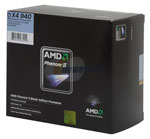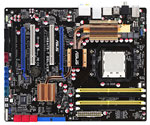AMD Performance Midrange
The introduction of Phenom II has made putting together an AMD Performance Midrange a joy again. While the Phenom was an honest competitor at the price points where AMD chose to compete, the poor overclocking of the AMD Phenom compared to Intel Core 2 dual/quad-core processors was always a nagging reality. Phenom II changes all that, and AMD in 45nm clothes is once again a screaming overclocker. We reached 3.9GHz in our testing for the Phenom II launch with a Phenom II 940 CPU. That same CPU is the starting point for our AMD Performance Midrange PC.
| AMD Performance Midrange PC | ||
| Hardware | Component | Price |
| Processor | Phenom II x4 940 Black Edition (3.0GHzx4 125W 4x512KB L2, 6MB L3) |
$275 |
| Cooling | Tuniq Tower 120 | $46 |
| Video | SAPPHIRE 100251SR Radeon HD 4870 X2 | $400 |
| Motherboard | ASUS M3A79-T Deluxe | $189 |
| Memory | G Skill DDR2-1100 (PC2-8800) 4GB Memory Kit F2-8800CL5D-4GBPI | $90 |
| Hard Drive | Seagate Barracuda 7200.11 ST310000333AS 1TB | $110 |
| Optical Drive | LG BD/HD DVD / 16x DVD+/- RW GGC-H20LK | $99 |
| Audio | Creative 7.1 Sound Blaster X-FI Titanium | $90 |
| Case | Antec Nine Hundred Black Steel ATX Mid Tower | $100 |
| Power Supply | SILVERSTONE ST70F 700W SLI Ready CrossFire Ready 80 PLUS Certified Modular Active PFC Power Supply | $100 |
| Display | ASUS VW246H Black 24" 2ms(GTG) HDMI Widescreen LCD Monitor (1920x1080) | $290 |
| Speakers | Logitech G51 155 watts RMS 5.1 Surround Sound Speakers | $90 |
| Input | Microsoft CA9-00001 Black PS/2 Standard Keyboard and Optical USB/PS2 Mouse - OEM | $16 |
| Operating System | Microsoft Vista Home Premium OEM | $99 |
| Bottom Line | $1994 | |
 |
You can read our review of the Phenom II X4 for additional information. The Phenom II 940 X4 at 3.0GHz is the fastest of the currently shipping AMD Phenom II processors. The Phenom II is very similar in L2/L3 cache configuration to the recently introduced Intel Core i7. Performance is also comparable to the best Intel chips. As the first 45nm AMD processors the Phenom II also overclocks very well, finally approaching the overclocking levels enjoyed by Intel since the introduction of the Core 2 Duo.
 |
We've paired the Phenom II 940 with the superb ASUS M3A79-T Deluxe. At $190 the ASUS is not cheap or even a great value for a 790FX/SB750 setup, but it is one of the most loaded and best performing AMD boards we have used this year. ASUS loads the board with Gigabit LAN, IEEE 1394 support, four PCI-E x16 slots (dual x16, tri x16/x8/x8, or quad x8), two PCI slots, a single eSATA port, and six 3Gb/s SATA ports featuring RAID 0/1/10/5. The M3A79-T Deluxe also works very well with Phenom II and end-users will not be disappointed in performance or overclocking capabilities.
The ASUS also includes superb onboard sound with the ADI AD2000B 8-channel HD audio. This is probably the best onboard sound solution we have tested so far. A Creative 7.1 Sound Blaster X-FI Titanium audio card was included in the components mostly for game compatibility. You can save $90 and use the onboard ADI sound without sacrificing much if anything in sound quality.
 |
The GPU choice is the top-performing Sapphire 100251SR Radeon HD 4870X2. This dual-GPU card is an exceptional performer on the 790FX chipset, as you would expect. The selling price has been around $500, but with current promotions you can buy this Sapphire 4870X2 for just $400. That is an exceptional buy that delivers top performance at a very fair price, and if you ever want more gaming power a quad-GPU (two 4870X2 cards) is an option, albeit one we don't really recommend unless you have a 30" LCD.
The Tuniq Tower 120 cooler was also used on the AMD Value Midrange System described on page 4. The rest of the components are the same as the Intel Performance Midrange PC. This includes the Seagate 1TB hard drive, the LG GGC-H20LK BD/HD reader and 16X DVD burner, the Antec Nine Hundred case, the Silverstone 700W PSU, the Logitech G51 powered speakers, the ASUS 1080p 24" 1920x1080 LCD Monitor, the Microsoft OEM keyboard/optical mouse, and Microsoft Vista Home Premium OEM. You can find more information on these choices on the previous Intel Performance Midrange page or on page 3.










77 Comments
View All Comments
Wesley Fink - Monday, January 12, 2009 - link
We have revised the comment to more accurately reflect what we were trying to convey. We don't want to leave the wrong impression on this. Core i7 is definitely the fastest current CPU, but Phenom II competes with i7 much better than Phenom. Phenom II also has a cheaper $235 CPU that offers terrific performance for the price7Enigma - Monday, January 12, 2009 - link
Thank you for the revision. I did not want it to seem that I thought you were being biased towards the Phenom II, just that it was a bit misleading in its original form. While architecturally it is closer to the Core i7, performance-wise it's closer to the Q9300/Q9400.I think for a mid-grade build the Phenom II is probably in a sweet spot as current high pricing for DDR3 ram and the motherboard (not to mention questionable mobo stability) make total system costs much higher for an i7 build.
As it is, I'll be building a very inexpensive system based off your $1500 Intel dual-core system as I game on a 19" LCD and do very little work that requires/is enhanced by a quad core. It's going to be a hold over system for a year or two and so I thank you for the 775 mobo and ram recommendation.
7Enigma - Monday, January 12, 2009 - link
*speaking of the 920, not the 940.7Enigma - Monday, January 12, 2009 - link
*PhenomTo add from Anand's own 920/940 review:
"Looking through the performance results, it's also worthwhile to recognize just how fast Intel's Core i7 is. Across the board Core i7 is the fastest thing out there. If the motherboard guys could get X58 board pricing down below $200 and DDR3 memory was available at the same price as DDR2, then the i7-920 would be the clear recommendation. The entry-level Core i7 is pretty much faster than the-top end Core 2 Extreme or the Phenom II."
and
"We must not forget that Phenom II is competitive with a 45nm derivative of a 2+ year old architecture."
Again I'm not bashing AMD's Phenom II chips, just that it is very misleading to say the performance is more in line with the i7.
Wesley Fink - Monday, January 12, 2009 - link
All of your comments add to the perspective on Phenom II. I believe I made it very clear that at $2000 the entry i7 was likely faster than the Phenom II. I also said on p.4 "Phenom II performance is more in line with Intel’s latest Core i7" and that is certainly true. The L3 cache of Phenom II is definitely more like i7 than the cache design of the Phenom CPU.However, Anand also points out the real advantage in the CPU/Board price enjoyed by the entry Phenom II 920. As I also said Intel's cheapest i7 is $300. There is no $235 i7 and cheap but capable motherboard as there is for Phenom II.
The article was crystal clear that Intel still owns the top, and that is i7, but AMD is competitive now in the mid-range to lower high end, where it was not before. This is not being a fan-boi as I personally run i7, but if I've given AMD a little more slack in this article I will not apologize. AMD has been trailing Intel for a long time, and in fairness Phenom II performance and overclocking came as something of a surprise to reviewers. Most did not expect the chip to be as comnpetitive as it is. AMD deserves a little credit here. I will probably use a Phenom II in my next build, as competition is good for all of us.
strikeback03 - Monday, January 12, 2009 - link
I was wondering about that as well. Anand's launch review of Phenom II seems to show that outside of gaming the i7 920 typically holds 10-20% better performance, with occasional tests showing even more. So at the $2000 price point that would likely make the AMD system the better gaming system due to the video card, but the i7 system likely faster in most other applications.Are any of the ~$200 X58 motherboards going to offer 6 RAM slots? 12GB would be even more expensive with only 4 slots.
As the PCIe X1 slots are often lost in an SLI/Crossfire setup, do any of these boards have trouble using a X1 sound card in an X16 slot? IIRC someone reported previously that some boards didn't like running X16 slots slower than X4.
Jaramin - Monday, January 12, 2009 - link
Somehow, this doesn't feel very midrange to me. It's as if the class was defined by the price instead of the performance.The value midrange aught to be performance midrange, and performance midrange is clearly high end, because one bumb ahead leads us to ultra-high end, you know, the machines we dream to have but would never buy?
Wesley Fink - Monday, January 12, 2009 - link
We did not use the term Midrange to start an argument, although a discusiion of the definition of Midrange is always interesting. Since we described our Bargain Systems as Under $1000 I have changed the title description to $1000 to $2000. I hope that removes any confusion about what is covered in the guide.Wesley Fink - Monday, January 12, 2009 - link
From the Introduction:"Midrange can start as low as $1000 and extend all the way up to around $2000, which gives a lot of flexibility in terms of choosing components. In this era of declining prices and increasing value, the midrange also covers a wider area than in the past - just as we saw in the under $1000 segment. Our budget systems near $1000 were really representative of what we might have called midrange in the past. Similarly, our $2000 system is closer to what may have been defined as high-end in earlier guides.
It's fair to ask, then, why we haven't tossed the price classes for our guides and defined new ones. That option was considered, but the fact remains that high-end prices have not declined like midrange and entry prices. New architectures have also been recently introduced at the high-end, so the definition of high and mid are shifting as the Intel Core i7 and Phenom II move into our computing space. We are already seeing a few X58 boards that will be selling for around $200, which would allow a decent Core i7 build at around $2000. Similarly, you can build a very capable Phenom II box for that same $2000."
AntiM - Monday, January 12, 2009 - link
I consider midrange to be in the $600 to $800 price range.